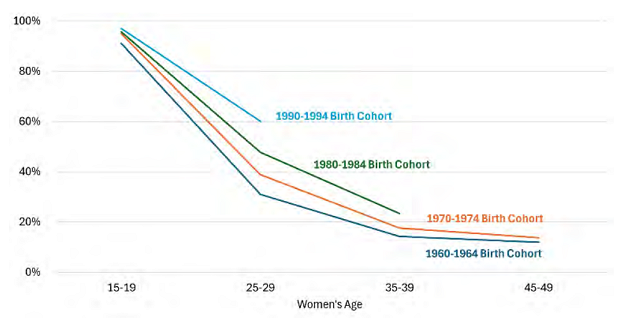Highlights
- The story of declining divorce isn’t primarily a story of stronger marriages, but of a failure to make matches in the first place. Post This
- Current trends suggest more men and women are giving up on their hopes for a lasting partnership and a family. Post This
- The declining divorce rate is much more a compositional effect, driven by who isn’t getting married than it is a victory for marriage preparation and promotion. Post This
Could a decline in U.S. divorce rates, as recently reported here at IFS, be bad news? A couple entering into their first marriage in the 1990s had about a 47% chance of splitting up, while newlyweds today are estimated to have only a 40% chance of divorcing. It’s still far from what we would desire for an institution intended to be “till death do us part,” but the decline in divorce is a small ray of hope for the 88% of Americans who falsely believe the divorce rate is increasing. Still, the overall picture is bleak.
That’s because marriage rates have dropped sharply in tandem with the decline in divorces. As Brad Wilcox notes in his recent Atlantic article, “Why Marriage Survives,” Census data shows that the share of prime-age adults (25 to 55) who are married has fallen from 83% in 1960 to 57% in 2010. Morgan Stanley projected (based on data through 2019) that by 2030, fully 45% of prime-age women would be single. But the projected rise in singleness is not the fulfillment of a decreasing desire to be married: 76% of high school senior girls and 69% of high school senior boys said in 2020 they expect to get married one day. Sadly, a large number of them are on track for disappointment.
The decline in marriage isn’t just a matter of a shift to cohabitation. More adults are spending their prime years alone. The Pew Research Center has calculated that in 2019, 38% of adults aged 25-55 were unpartnered, compared to 29% in 1990. Cohabiting has risen only modestly as marriage has declined more sharply, and the end result is that more people spend their lives alone.
So, the story of declining divorce isn’t primarily a story of stronger marriages, but of a failure to make matches in the first place. In “Why Is Fertility So Low in High Income Countries?” Melissa Kearney and Phillip B. Levine plot out an American woman’s chance of being married by a particular age, broken out by age cohorts. Those women born in the early 90s are particularly unlikely to make matches.
Percent of Women Never Married by Age and Birth Cohort

Source: “Why Is Fertility So Low In High Income Countries?” Melissa Schettini Kearney & Phillip B. Levine, NBER Working Paper 33989, July 2025, used with permission.
The decline in marriage has also not been uniform. Wealthier and better-educated singles are more likely to get married than those who are poorer and less educated. Marriage rates also have a significant racial gap. This means the declining divorce rate is much more a compositional effect, driven by who isn’t getting married than it is a victory for marriage preparation and promotion.
Pro-marriage conservatives aren’t out to improve the divorce rate at any cost, but to prepare more people to desire the graces of marriage and be prepared to make and keep the vows that marriage entails. It would be a hollow victory to teach the Success Sequence, for example, if it simply convinced more people that marriage was out of reach. The goal should not be to dissuade marginal marriages but to prepare men and women to make strong marriages.
The pro-family goal is not a smaller, purer remnant of successful marriages. The goal should be for the vast majority of normal people to be marriageable and to know themselves as such.
So, what would represent genuinely encouraging news about marriage in America? It would help to see the divorce rate decline while marriage rates rise. Then we might have reason to believe that people were getting better at being married, rather than that our culture was convincing people to give up on marriage. It would be good to see a reversal of recent trends in the Monitoring the Future study of high school seniors. Boys and girls have, in recent years, seen about a 10% drop in how many of them expect they could be “very good” spouses.
Similarly, a strong future for marriage probably requires a reversal in recent youth trends that show a sharp rise in neuroticism and a corresponding drop in conscientiousness. Care for other people and resiliency are both critical to navigating the ups and downs of marriage. Thinking less of others and becoming more anxiously fixated on one’s own thoughts and feelings makes it harder to match and stay married.
One statistic I’d like to see is how many people of marriageable age can point to strong examples of successful marriages, especially of peers just a few years ahead of them. Being ready to attempt marriage requires potential spouses who know what marriage is. It helps a lot to see more than one example of a good marriage, so you don’t become cargo-cult fixated on an incidental feature of your only strongly married friends. When marriage declines, young singles are in a negative feedback loop—they see fewer examples and so marriage becomes more abstract and less achievable.
Churches and schools can also try to offer support earlier in the process than when a newly engaged couple shows up to ask about a wedding date. Part of high school sex education as well as teen groups at church should be hearing from a range of couples about how they met and how they decided they were ready for marriage. It makes a difference to think of “Should we get married” as a question you can actively ask, not one for which you passively await revelation.
One particularly interesting experiment is happening at an non-denominational church in Dallas. Concord Church offers free weddings to cohabiting couples, provided they go through couples counselling. If they decide not to get married, the church covers the first month rent for one member of the couple to move out into their own place. The goal is to treat marriage as an urgent question and to help couples who are tempted to delay it for financial reasons.
Ultimately, the pro-family goal is not a smaller, purer remnant of successful marriages. The goal should be for the vast majority of normal people to be marriageable and to know themselves as such. Current trends suggest more men and women are giving up on their hopes for a lasting partnership and a family. No matter how good that makes the divorce toplines look, that’s still bad news for American families and America’s future.
Leah Libresco Sargeant is the author of Building the Benedict Option and runs Other Feminisms, a substack community.
Editor's Note: The opinions expressed in this article are those of the author and do not necessarily reflect the official policy or views of the Institute for Family Studies.










